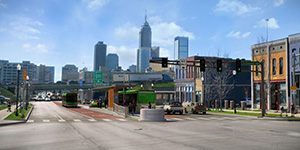About 59% of transit trips are trips to work, and businesses located on transit routes have significantly less employee turnover. Indianapolis currently ranks 64th in job access via transit.
Only about 1 of every 20 kids born in poverty in Indianapolis can climb to the top of the economic ladder, making Indy one of the least upwardly mobile cities in the U.S. (ranked 46th of 50). Transit provides reliable, low-cost access to work and school.
Millennials (born 1980-2000) are now the majority of the workforce, and attracting talented young workers is key to local economic development. Surveys and data show that Millennials are looking for walkable, mixed-use, transit-served neighborhoods.
The average transit rider gets 3 times more physical activity per day than non-riders by walking to stops and final destinations, and they’re also 170 times less likely to be in an accident than car passengers.
Indy households spend about $12,000 per year on transportation. On average, households in “transit-rich” neighborhoods save $6,000.
Investments in transit typically generate $3 for every $1 invested,9 but it can be much more. Cleveland’s Euclid Avenue HealthLine generated $114.54 in economic development for every dollar, leveraging nearly $6 billion in development along the corridor.
Those too old, too young, banned, or facing
a disability that prevents them from driving experience major isolation. They make 15% fewer trips to the doctor, 59% fewer shopping trips and restaurant visits, and 65% fewer trips for social, family, and religious activities than drivers do.
About 79% of Indy’s senior citizens have poor transit access, which ranks 39th out of the 46 mid-sized U.S. metros.13 Indy’s over-65 demographic will continue to grow exponentially over the next decade; seniors are living longer, and they’re facing major barriers to driving as they try to age in place.



